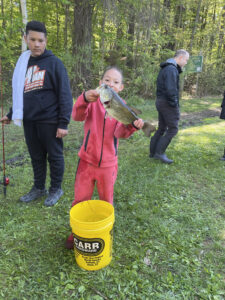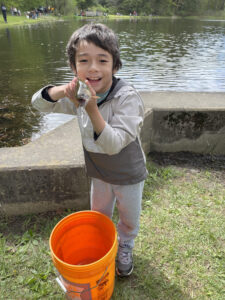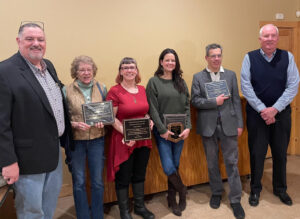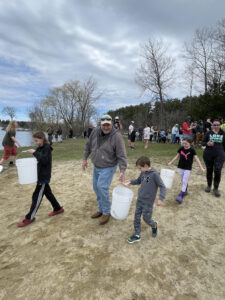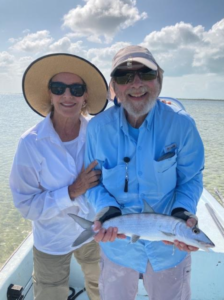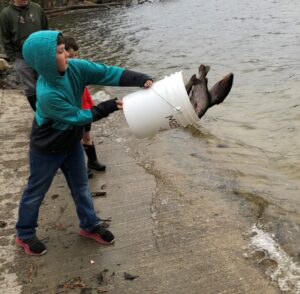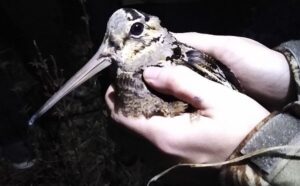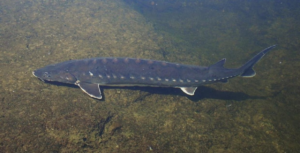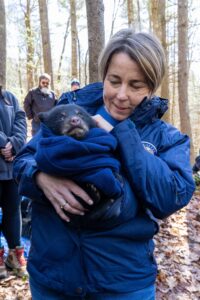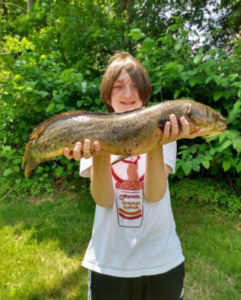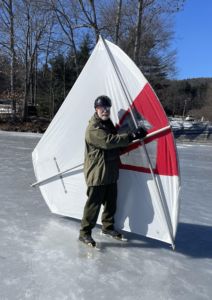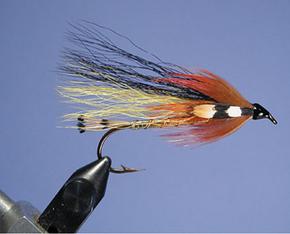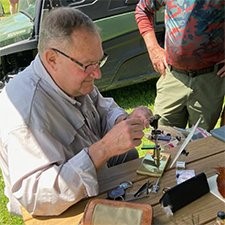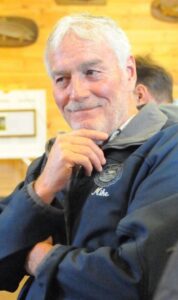Last Saturday, May 11, the Wild Acres Youth Fishing Derby took place with over 100 children registered. The age range was from 2 1/2 to 14 years old. The weather was very cooperative and it was a lovely morning.
This was the 10th year that the City of Pittsfield Conservation Commission and Lyon Aviation sponsored the event. Representing the City of Pittsfield were Maddy Brown, Recreation & Special Events Coordinator and Rob Van Der Kar, Pittsfield Conservation Agent. Assisting the anglers were Onota Fishing Club volunteers. Dave’s Sporting Goods Store, Onota Boat Livery and Parks and Recreation provided bait, fishing poles and tackle; Lyon Aviation provided the brook trout which came from the Berkshire National Fish Hatchery in New Marlborough. Ozzie’s Steak and Eggs provided free food vouchers to 100 people from their food truck. Berkshire Regional Planning Commission (BRPC) and the Onota Boat Livery donated a number of fishing poles that were raffled off throughout the morning.
Only 1 of the 400 stocked brook trout was caught as bass were the most popular catches of the day. Actually, the largest fish caught was a 17 inch, 2.2 lbs. largemouth bass, which was caught by Troy Sparrow.
Mylles Tagole caught the sole trout. Some pumpkinseeds, bullhead and pond shiners were also caught.
I can’t tell you how many folks commented on the fond memories they had of their dads or granddads bringing them to this little pond to learn how to fish. Today, the tradition continues and now they are bringing their kids and grandkids.
One notable person missing this year was the late Clem Caryofilles of the Onota Fishing Club who recently passed beyond the riverbend. For many years he was heavily involved in this event and we really missed him. Incidentally, age is taking its toll on the Onota Fishing Club membership and its numbers are shrinking. Perhaps its time for the next generation of folks to step up to the plate to keep this tradition alive.
Our hats are off to Lyon Aviation, the City of Pittsfield, the Onota Fishing Club, BRPC and everyone involved to make this event a great success.
A huge thank you goes to Maddy Brown for providing information on the derby winners and other pertinent information.
Trout stocking
The following local waters were scheduled to be stocked with trout last week, subject to change: Deerfield River in Buckland, Charlemont, and Florida, Green River in Alford, Egremont, and Great Barrington, Housatonic River C&R in Lee and Stockbridge, Housatonic River East Branch in Dalton and Hinsdale, Konkapot River in Monterey and New Marlborough, Littleville Reservoir in Chester and Huntington, North Pond in Florida, Westfield River East Branch in Chester, Cummington and Huntington, Westfield River West Branch in Becket, Chester, Huntington and Middlefield, Onota Lake, Richmond Pond and Stockbridge Bowl.
MassWildlife staff honored
In a recent public announcement, current and former MassWildlife staff were recognized for their contributions to fisheries and wildlife conservation.
The Robert McDowell Award
This is the highest honor presented by the Directors of the Northeast Association of Fish and Wildlife Agencies to honor career professionals who have made significant contributions to advance fish and wildlife conservation in the Northeastern United States and eastern Canadian Provinces. Jim Cardoza, retired MassWildlife Biologist, was presented with this award at the 79th annual Northeast Fish and Wildlife Conference hosted by MassWildlife on Cape Cod in April.
Cardoza’s accomplishments during his long tenure as a wildlife biologist in Massachusetts are impressive. Notably, he was the key architect of the restoration of wild turkeys in the Northeast. Turkeys were absent in Massachusetts until reintroduction efforts began in the late 1960s. Today, Massachusetts’ wild turkey population is estimated at around 35,000 birds! Jim also pioneered innovative methods for studying black bears and became one of the country’s leading experts on this species. He shared his expertise by publishing dozens of peer-reviewed articles and presenting at professional conferences ensuring that other wildlife professionals had access to the latest wildlife management methods and research results.
This honor took on special significance since Mr. Cardoza accepted the Robert McDowell Award at his 50th Northeast Fish and Wildlife Conference.
William T. Hesselton Memorial Award
Every year, a group of wildlife professionals from 13 Northeast states nominate an individual who has made significant contributions to wildlife conservation and to wildlife management and hunter training programs. Susan Langlois, MassWildlife’s Hunter Education Program Administrator, received the William T. Hesselton Memorial Award at the Northeast Fish and Wildlife Conference. Langlois has dedicated her career to the conservation of Massachusetts wildlife and to providing top-notch instruction to the sporting community. Drawing on her expertise as a biologist, Susan has become an advocate for science-based wildlife management and a national leader in developing modern hunter education program standards. She helped develop a national trapper education course and is an instructor and advisory member for the national Conservation Leaders for Tomorrow program.
Berkshire County League Sportsperson of the Year
The third award recipient was Leanda Fontaine, MassWildlife’s Western District Aquatic Biologist, who was named (BCLS) 2023 Sportsperson of the Year. The award was given by the BCLS at the Silvio O. Conte Memorial Banquet on April 13. During her nearly 20 years with MassWildlife, Fontaine has been involved with a variety of statewide fisheries research and conservation projects. In her current role, she oversees fisheries projects in western Massachusetts, plans trout stocking activities and public stocking events, and supports learn-to-fish classes in the Berkshires. Leanda has implemented several successful invasive water chestnut removal projects, contributes her knowledge to lake and pond management discussions, and is the MassWildlife representative on the interagency scientific dive team.
All three were also honored by the MA Fish & Wildlife Board at its May 15 meeting.
Annual Harry A Bateman Memorial Jimmy Fund Fishing Derby coming up
The 32nd Annual Harry A. Bateman Memorial Jimmy Fund Fishing Derby will take place on Saturday, June 1, (rain or shine), at the Frank Controy Pavilion at Onota Lake in Pittsfield, from 6:00 a.m. to 12:00 p.m. No fishing license is required because it is Free Fishing Weekend.
This fishing derby is perhaps the most important and largest of our local fishing derbies. Open to the public, its purpose is to raise money for the Jimmy Fund – Dana Farber Cancer Institute. All proceeds will be donated to the Jimmy Fund in memory of Harry A. Bateman a former member of Central Berkshire Bowman & I.U.E. Local 255 who was well known throughout Berkshire County and who became a victim of cancer in 1992.
Many trophies and prizes will be awarded to the winners of the fishing derby – 8 trophies for children, 4 trophies for adults and 3 trophies that can be won by adults or children. There is even a special category for those carp fishing with a bow & arrow. All fish must be weighed in at 12:00 p.m. and can be caught at Onota Lake from a boat or the shore.
The fee, which includes food and beverage, is $10 for adults, $5 for children 14 years old and younger. Advanced tickets may be purchased at Avid Sports, 201 West Housatonic Street, Dave’s Sporting Goods, 1164 North Street and Onota Boat Livery, 436 Peck’s Road, all in Pittsfield. Everyone needs to register at the Frank Controy Pavilion. Even if you can’t make the derby, donations to the cause will be graciously accepted.
June 1–2, is Free Freshwater Fishing Weekend
Mark your calendars for this year’s Free Freshwater Fishing Weekend on June 1 and 2. No license is required to fish any public lake, pond, reservoir, stream, or river in Massachusetts from 12:00 am. Saturday, June 1 until 11:59 p.m. Sunday, June 2.
For saltwater anglers, Free Saltwater Fishing Weekend is June 15–16.
Other than on Free Fishing Weekend, you need a license to fish in fresh water if you are 15 or older. If you’ are 15–17 or 70 and older, your license is free.
All other regulations, including catch limits, apply during Free Fishing Weekend. Before heading out on the water, make sure you know the rules.
Funds from fishing license sales support MassWildlife’s fisheries research, fish stocking programs, and angler education programs.

